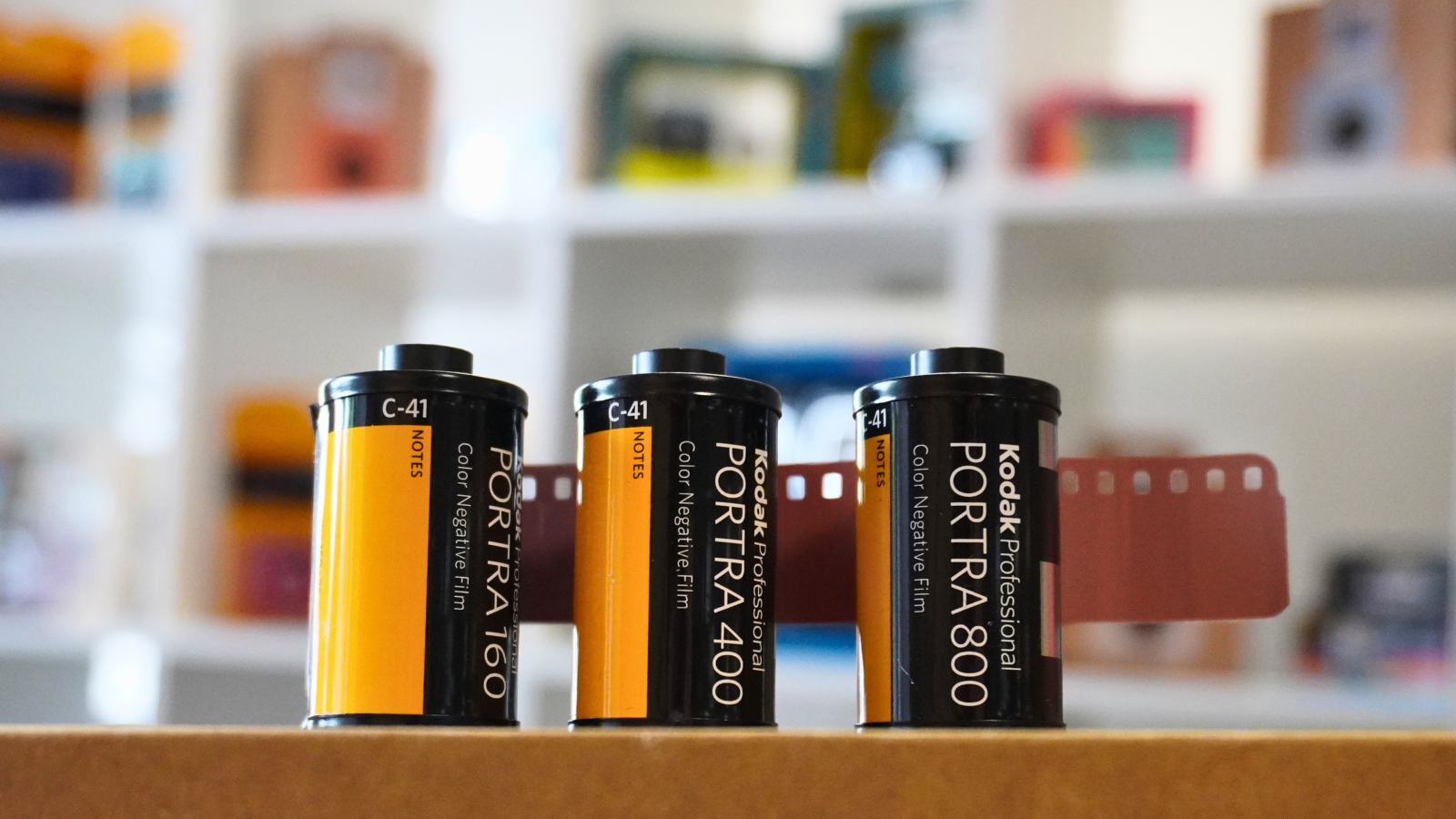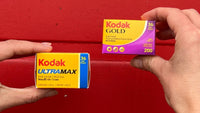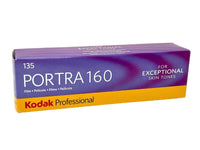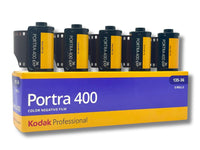Featured articles
Shop the article

Unveiling the Perfect Portra: A Comprehensive Comparison of Portra Film Variants
By Emma Lloyd
In the world of film photography, Kodak Portra has established itself as one of the big dogs! It is a much loved favourite throughout the community, with many memes, and merch having been made in its honour. It has an unparalleled ability to capture skin tones and has become a staple for portrait photographers worldwide. But, there is more than one Portra film to choose from. With three variants- Portra 160, Portra 400 and Portra 800- each with their own unique characteristics, how does one choose?
In this blog we will delve into the world of Portra and uncover the secrets behind each popular emulsion and what sets these films apart. Whether you're a seasoned film photographer or a curious enthusiast, this guide will provide you with the knowledge and insights to choose the perfect Portra film variant for you.
A brief History of the Portra Range
The Kodak Portra film series has evolved over the years, starting with the NC (Natural Color) and VC (Vivid Color) versions. Introduced before the current lineup, NC (Natural Color) films were designed to offer a more neutral colour balance and accurate skin tones, while VC (Vivid Color) films provided enhanced saturation and vibrancy for more punchy colours. However, these versions were eventually discontinued and replaced with the current emulsions: Portra 160, Portra 400, and Portra 800. But if you are lucky, you can still find some expired rolls of the original Portra films in the depths of eBay!
The modern Portra films were introduced in 1998, with slightly more refined recipes. They have become renowned for their fine grain, smooth colours, and excellent skin tones, making them popular choices among film photographers seeking a classic aesthetic and reliable performance in various shooting conditions. Check out this link for one of the original product catalogues of the Portra range on the Kodak website. The films are available in 35mm, 120 and large format sheets.
Understanding the different variants of Portra film
Portra film is available in three main variants: Portra 160, Portra 400, and Portra 800. Each variant offers a unique set of characteristics that cater to different photography styles and preferences. Let's take a closer look at what sets these films apart.
Portra 160: Characteristics and uses
Portra 160 is known for its fine grain and exceptional colour reproduction. It offers a smooth and subtle tonal range, making it perfect for capturing delicate details and soft skin tones.
 (c)@eyeofthetyne, Peter Robinson, Carefree childhood
(c)@eyeofthetyne, Peter Robinson, Carefree childhood
"The focus and the skin tones. I love Kodak portra for family photos like this. I really think shooting on film gives the photos a beautiful nostalgic feel."
Due to its lower ISO, this film variant will perform best in well-lit and sunny situations. It is a perfect summer film. However, don’t be put off by the unusual speed rating; although it has a box speed of 160, this film will still produce excellent photographs when rated at 200. We find a lot of customers are put off by this film's speed, especially if their camera doesn’t have a setting for ISO 160, but you can still get great results from pushing it ever so slightly to 200!
 (c) Paul McKay, here is an image taken on Portra 160 that Paul pushed to 200 ISO.
(c) Paul McKay, here is an image taken on Portra 160 that Paul pushed to 200 ISO.
The colours rendered by Portra 160 are warm and slightly muted, creating a nostalgic and dreamy aesthetic. The film is available in 35mm, medium and large format. Have a look at some of our video review of the film below.
Portra 400: Characteristics and uses
Portra 400, with a slightly higher ISO is a more versatile film variant that strikes a balance between fine grain and higher sensitivity. With its increased ISO rating, it performs exceptionally well in low-light conditions, making it a popular choice for indoor and evening portraits. The colours produced by Portra 400 are vibrant and rich, with excellent contrast, whilst still having that classic Portra look.

(c) @jakesnook_, an image taken on Portra 400. You can see why people love it for portraits!
This film variant is known for its ability to capture a wide dynamic range, ensuring that both shadows and highlights are well-preserved. Whether you're shooting in natural light or using artificial lighting setups, Portra 400 delivers consistent and stunning results. It is available in 35mm, medium and large format.
Portra 800: Characteristics and uses
Portra 800 is the go-to film variant for low-light and high-speed photography. Portra 800 is apparently based on Kodak’s VISION 2 technology (whereas Kodak Portra 400 and 160 are based on the VISION 3 technology). With its higher ISO rating, it offers excellent performance in challenging lighting conditions, such as dimly lit interiors or nighttime environments. This film variant excels at capturing fine details even in situations with limited available light. The colours produced by Portra 800 are bold and saturated, with a pleasing level of contrast. It is available in 35mm and medium format. (c)Aukje Kastelijn @aukjek, Underwater Landscape
(c)Aukje Kastelijn @aukjek, Underwater Landscape
"If you, like me, love shooting with the Nikonos underwater, Portra 800 is a great film. The high iso reduces the risk of motion blur, and the colours are always gorgeous."
Portra 800 featured in one of our bi-annual Kodak Photo competitions. Check out the video below to see the winning entries, and get some inspiration!
Choosing the right Portra film for your photography style

(c) Holly Hang, @photoxcore_archive, Ice Cream in Brighton, taken on Portra 160
"It captures the great weather on the day the photo was taken. Also, that it's in focus because shooting with a Hasselblad SWA in one hand and having an ice cream in the other hand, while trying to be still is hard!"
When selecting the perfect Portra film variant for your photography style, it's important to consider factors such as lighting conditions, desired aesthetic, and shooting environment. Here are some guidelines to help you make an informed decision:
1. Consider lighting conditions: If you primarily shoot outdoors or in well-lit settings, Portra 160 would be an excellent choice. For indoor or low-light scenarios, Portra 400 or Portra 800 would be a more reliable option, without having to compromise on shutter speed.
2. Desired aesthetic: If you prefer a softer and more nostalgic look, Portra 160 is the way to go. For vibrant and rich colours with excellent contrast, Portra 400 is a reliable option. If you need to push the limits of low-light photography, Portra 800 is the ideal choice.
3. Shooting environment: If you often find yourself in fast-paced situations or capturing candid moments, Portra 800's higher sensitivity will allow you to freeze the action and capture details even in challenging lighting conditions.
4. Scan quality: Since releasing the film in 1998, Kodak has also updated the Portra 160 and Portra 400 films to improve image and scanning quality, so if you are after some great quality scans, perhaps consider these emulsions. Portra 800 will provide a more traditional look.
By considering these factors, you can narrow down your choices and select the Portra film variant that best suits your photography style and needs.
Tips for shooting with Portra film

(c) @elliottmariess, Last days of summer
"The overall colour palette came together beautifully with the last moments of light. That coupled with the detail from the 120 film made me super happy with the results. I really enjoy overexposing it slightly to get really rich contrast."
Now that you've chosen the perfect Portra film variant for your portrait session, here are some tips to help you make the most of your film photography experience:
1. Metering and exposure: Properly metre your scene and expose your images correctly to ensure accurate colour reproduction and optimal results. Pay attention to highlights and shadows to maintain detail in both areas.
2. Experiment with lighting: Portra film is versatile and can adapt to different lighting conditions. Experiment with natural light, artificial lighting, or a combination of both to create unique and stunning portraits. When shooting Portra 160 - If you are working with it in natural light, it is recommended to use a reflector that will compliment your subject’s skin tones well.
3. Take advantage of the film's dynamic range: Portra film offers an impressive dynamic range, allowing you to capture details in both highlights and shadows. Use this to your advantage when composing your shots and embrace the film's ability to preserve subtle nuances.
4. Explore different development techniques: The development process plays a crucial role in achieving the desired look of your images. Experiment with different development techniques or consult a professional lab to discover new possibilities and enhance the characteristics of your chosen Portra film variant.
5. Manipulate the film’s sensitivity- Shooting at different ISOs can have a great effect on your final images. For Portra 400 try shooting it at ISO 200 and develop it at ISO 320. And for Portra 160, push it to 200.
By following these tips, you can elevate your film photography skills and create captivating photographs that truly showcase the beauty of your subjects.
- Need help understanding ISO? read our blog 'Film Speed Explained: What It Is and How It Affects Your Photos'.
- Want to understand more about pushing film? read our blog 'The Art of Pushing Film: A Comprehensive Guide'
In conclusion, Kodak Portra offers a range of film variants that cater to different photography styles and preferences. Whether you're drawn to the warm and dreamy tones of Portra 160, the vibrant and contrasting hues of Portra 400, or the high-speed capabilities of Portra 800, each variant has its own unique characteristics that can enhance your portraits.
By understanding the distinctive qualities of each Portra film variant and considering factors such as lighting conditions and desired aesthetic, you can choose the perfect film for you.
With its unparalleled ability to capture skin tones and delicate nuances, Portra film continues to be a favourite among portrait photographers, unlocking the potential of film photography in capturing the essence of human beauty. So, grab your camera, load up your preferred Portra film, and embark on a journey of capturing timeless portraits that will leave a lasting impression. For more inspiration, head to our product pages to see some customer reviews and stunning photos from the community!
Follow us on Social Media
Subscribe to our newsletter 💌
Sign up for our newsletter to stay up to date on film photography news, sales and events:
Free Tracked Shipping
On all UK orders over £50
Passion For Film
An unbeatable range and an on-site lab
Our Customers Trust Us
Thousands of independent 5* reviews
All Deliveries are Carbon Neutral
Independently audited and verified by Planet
- Opens in a new window.





